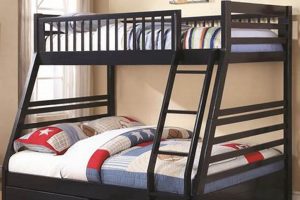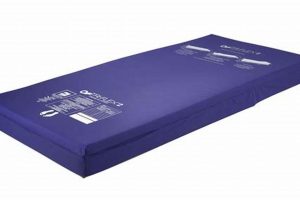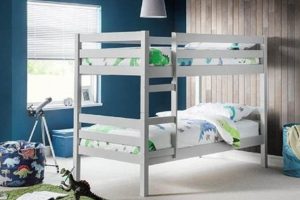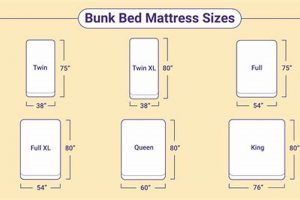The compatibility of a specific type of mattress with a movable bed frame is a common query among consumers. These mattresses, combining both innerspring coils and foam layers (typically memory foam or latex), offer a balance of support and comfort. Understanding whether this mattress construction is suitable for use on a bed frame that can change position is essential for ensuring both comfort and product longevity.
The ability to use this mattress design on an adjustable base offers several advantages. The conformance of the mattress to the bed’s positions can improve sleep quality by properly aligning the spine and reducing pressure points. Historically, adjustable bed frames were primarily used in hospitals, but their benefits for comfort and lifestyle have led to increased popularity in residential settings. The potential for enhanced comfort and improved sleep posture makes the compatibility of different mattress types with these frames a significant factor for consumers.
This analysis will explore the factors that determine if a hybrid mattress is appropriate for use on an adjustable bed, including mattress flexibility, weight considerations, and potential warranty implications, ensuring informed decision-making for consumers.
Considerations for Hybrid Mattress and Adjustable Bed Compatibility
Selecting the appropriate mattress for use with an adjustable bed requires careful consideration to ensure both comfort and longevity of the product. The following points outline key factors to evaluate.
Tip 1: Evaluate Mattress Flexibility: A hybrid mattress intended for use on an adjustable bed should possess sufficient flexibility to conform to the various positions of the base without sustaining damage. Mattresses with highly rigid coil systems may not be suitable.
Tip 2: Check Mattress Weight Limitations: Adjustable beds have weight capacity limits. Confirm that the combined weight of the mattress and individuals using the bed do not exceed the maximum specified weight. Exceeding the weight limit can damage the adjustable base.
Tip 3: Review Mattress Warranty Terms: Scrutinize the mattress warranty for clauses that may be voided by using the mattress on an adjustable base. Some manufacturers may not cover damage attributed to improper use, including incompatible bed frames.
Tip 4: Consider Edge Support Construction: Mattresses with weak or poorly constructed edge support may exhibit premature wear when used on an adjustable bed, particularly if individuals frequently sit on the edge of the bed in a raised position.
Tip 5: Assess Coil System Design: Individually wrapped coils generally offer greater flexibility and contouring ability compared to interconnected coil systems, making them a potentially better choice for adjustable bed compatibility.
Tip 6: Consider the Foam Density and Type: High-density foams (both memory and latex) tend to be more durable and can better withstand the repeated bending and flexing associated with adjustable bed use. Choose foams appropriate for adjustable usage.
Tip 7: Inquire About Adjustable Base Compatibility: When purchasing a mattress, directly inquire with the retailer or manufacturer about its compatibility with adjustable bed frames. Some manufacturers may offer specific models designed for such use.
Adhering to these considerations can mitigate the risk of incompatibility issues and ensure a more satisfactory and durable sleep system.
The following section will address frequently asked questions related to mattress and adjustable bed compatibility.
1. Mattress Flexibility
Mattress flexibility is a critical attribute when considering the use of a hybrid mattress on an adjustable bed frame. The ability of the mattress to bend and conform to the various positions of the adjustable base directly impacts both comfort and the structural integrity of the mattress over time. Inadequate flexibility can lead to discomfort, reduced support, and premature wear.
- Conforming to Angles and Curves
An adjustable bed frame alters its shape, creating angles and curves to elevate the head and/or legs. A flexible mattress can adapt to these contours without creating undue stress on its internal components. A less flexible mattress, in contrast, will resist bending, leading to uneven support and potential damage to the mattress structure. For example, a mattress with a stiff coil system may create pressure points when the bed is in a seated position.
- Stress on Coils and Materials
Repeated bending and flexing, as experienced on an adjustable bed, place considerable stress on the mattress’s coils, foam layers, and fabric covering. A mattress lacking adequate flexibility is more likely to suffer from broken coils, compressed foam, and tears in the fabric. For instance, a hybrid mattress with a thick, high-density foam layer may resist conforming to the bed’s shape, placing extra strain on the coil system underneath.
- Impact on Sleeper Comfort
A mattress that does not readily conform to the adjustable bed’s position can compromise the sleeper’s comfort. Gaps may form between the mattress and the bed frame, leading to uneven weight distribution and pressure points. A flexible mattress will maintain consistent contact with the body, even as the bed’s shape changes. As an illustration, a rigid mattress might not adequately support the lumbar region when the head and foot of the bed are elevated, resulting in lower back pain.
- Long-Term Durability
The degree of flexibility directly influences the lifespan of a hybrid mattress used on an adjustable bed. A more flexible mattress is better equipped to withstand the constant movement and adjustments, reducing the risk of premature wear and tear. In contrast, a stiff mattress will experience greater stress on its internal components, leading to a shorter lifespan. As a comparison, a mattress designed specifically for adjustable beds will often incorporate features, such as flexible coils and durable foam, to enhance its ability to withstand the rigors of adjustable bed use.
The interplay between mattress flexibility and the adjustable bed’s functionality is undeniable. Selecting a hybrid mattress with sufficient flexibility is paramount for ensuring optimal comfort, maintaining mattress durability, and realizing the full potential of an adjustable bed frame. The design and material composition of the mattress must be carefully evaluated to ensure compatibility with the adjustable base’s range of motion.
2. Weight Capacity
The weight capacity of an adjustable bed frame is a critical consideration when selecting a hybrid mattress. Exceeding the stated weight limit can lead to mechanic
al failure of the adjustable base, potentially voiding the warranty and necessitating costly repairs or replacement. The total weight must account for the mattress itself and all occupants who will use the bed. For example, a queen-size hybrid mattress may weigh between 80 and 120 pounds. If the bed is intended for two individuals, their combined weight must be added to the mattress weight to determine if the total exceeds the adjustable base’s specifications.
Adjustable beds typically have a maximum weight capacity ranging from 350 to 750 pounds. This limit is determined by the strength of the motor, frame, and lifting mechanisms. Overloading the bed can strain these components, leading to reduced functionality or complete breakdown. For instance, if a bed with a 400-pound capacity is supporting a 100-pound mattress and two individuals weighing 175 pounds each, the total weight of 450 pounds exceeds the limit, increasing the risk of damage. Some adjustable bases offer reinforced frames and stronger motors designed to accommodate higher weight capacities, but these models typically come at a higher cost.
Therefore, confirming that the combined weight of the hybrid mattress and occupants falls within the adjustable bed frame’s specified weight capacity is essential for ensuring the long-term functionality and safety of the adjustable bed system. Neglecting this factor can result in premature wear, mechanical failures, and potential safety hazards, undermining the intended benefits of an adjustable bed and hybrid mattress combination.
3. Warranty Restrictions
Warranty restrictions represent a critical factor in determining the suitability of a hybrid mattress for use on an adjustable bed. Mattress warranties often contain clauses that may be voided if the mattress is used in conjunction with an incompatible bed frame, including adjustable bases. A common restriction pertains to the type of support system, stipulating that the mattress must be used on a solid, flat surface or a specific type of foundation. Using the mattress on an adjustable base, if not explicitly approved by the manufacturer, may be considered misuse, thus nullifying the warranty.
The rationale behind these restrictions lies in the potential for adjustable bases to place undue stress on the mattress, leading to premature wear and tear. For instance, the constant bending and flexing associated with an adjustable bed may cause the mattress’s internal components, such as coils or foam layers, to break down more rapidly. Manufacturers implement warranty restrictions to protect themselves from claims arising from such scenarios. Consequently, before pairing a hybrid mattress with an adjustable bed, it is imperative to thoroughly review the mattress warranty for any specific limitations or exclusions pertaining to adjustable base usage. Failure to do so could result in the loss of warranty coverage in the event of mattress defects or damage.
In summary, the presence of warranty restrictions significantly impacts the assessment of whether a hybrid mattress is appropriate for use on an adjustable bed. These restrictions are designed to safeguard manufacturers from liabilities arising from misuse or incompatible support systems. Therefore, a careful examination of the warranty terms is essential to ensure that the mattress remains covered and that any potential issues can be addressed within the warranty period. Ignoring this aspect can lead to financial repercussions and the inability to claim warranty benefits for mattress defects or damage incurred while using an adjustable bed.
4. Edge Support
Edge support, defined as the reinforcement along the perimeter of a mattress, plays a critical role in determining the suitability of a hybrid mattress for use on an adjustable bed frame. The interaction between these two components significantly influences the mattress’s structural integrity, the user’s comfort, and the longevity of both the mattress and the adjustable base. Inadequate edge support, particularly when the bed is articulated, can lead to premature sagging, uneven weight distribution, and a compromised sleep surface. For example, when an adjustable bed is raised at the head, the mattress is subjected to increased pressure along its edges, especially where individuals sit or lie near the perimeter. A hybrid mattress lacking sufficient edge support in this configuration may exhibit significant compression, potentially causing discomfort and reducing the usable sleep surface.
The design of edge support varies across different hybrid mattress models. Some mattresses incorporate reinforced coils or high-density foam encasements around the perimeter to provide enhanced stability. These features help prevent the edges from collapsing under pressure, maintaining a consistent level of support across the entire surface of the mattress. Conversely, hybrid mattresses with minimal or poorly constructed edge support may experience accelerated wear and tear when used on an adjustable bed. Consider a scenario where an individual regularly sits on the edge of an adjustable bed while it is in a partially elevated position. Over time, the lack of adequate edge support can cause the perimeter of the mattress to deform, leading to a visible dip or sag. This not only diminishes comfort but can also affect the overall alignment of the spine during sleep.
In conclusion, the quality and construction of edge support are paramount when evaluating the compatibility of a hybrid mattress with an adjustable bed. Robust edge support mitigates the risk of sagging and uneven weight distribution, ensuring a more comfortable and supportive sleep experience. It is recommended to carefully examine the edge support features of a hybrid mattress before pairing it with an adjustable bed frame, prioritizing models that incorporate reinforced coils or high-density foam encasements. Doing so can prolong the lifespan of both the mattress and the adjustable base, while also maximizing the potential benefits of an adjustable sleep system.
5. Coil Design
The coil design within a hybrid mattress significantly influences its suitability for use with an adjustable bed frame. The type, arrangement, and gauge of the coils affect the mattress’s ability to conform to the adjustable base’s contours, its overall durability, and the distribution of support and pressure relief. Understanding these factors is essential for determining whether a given hybrid mattress is compatible with an adjustable bed.
- Individually Wrapped Coils (Pocket Coils)
Individually wrapped coils, also known as pocket coils, operate independently of one another, allowing them to conform more closely to the shape of the adjustable bed and the sleeper’s body. This design minimizes motion transfer and provides targeted support, which is particularly beneficial when the bed is in an elevated or contoured position. For example, if one section of the mattress is raised by the adjustable base, the pocket coils in that area will compress independently, while the surrounding coils remain relatively unaffected. This ensures that the sleeper receives consistent support and pressure relief, even as the bed’s configuration changes. Mattresses with pocket coils tend to be more flexible and adaptable to the movements of an adj
ustable bed compared to those with interconnected coil systems. - Interconnected Coils (e.g., Bonnell Coils, Continuous Coils)
Interconnected coil systems, such as Bonnell coils or continuous coils, feature coils that are linked together to form a unified support structure. While these systems can provide good overall support, they tend to be less flexible than pocket coils and may not conform as effectively to the contours of an adjustable bed. When an interconnected coil mattress is placed on an adjustable base, the entire coil system may bend or flex as a unit, potentially creating pressure points or uneven support. For instance, if the head of the adjustable bed is raised, the interconnected coils may pull on each other, causing the mattress to bow or buckle in certain areas. This can result in discomfort and may reduce the mattress’s ability to provide proper spinal alignment. Consequently, hybrid mattresses with interconnected coil systems are generally less suitable for use on adjustable beds.
- Coil Gauge and Density
The gauge (thickness) and density of the coils also play a role in determining a hybrid mattress’s compatibility with an adjustable bed. Lower-gauge coils (thicker coils) tend to be more durable and supportive but may also be less flexible. Higher-gauge coils (thinner coils) are generally more flexible but may not provide as much support or longevity. The optimal coil gauge and density will depend on the sleeper’s weight and preferences, as well as the specific design of the adjustable bed. For example, a heavier individual may require a hybrid mattress with lower-gauge coils to ensure adequate support and prevent sagging, even when the bed is in an elevated position. In contrast, a lighter individual may find that a mattress with higher-gauge coils provides sufficient comfort and flexibility. Coil density, measured as the number of coils per square foot, also affects the mattress’s ability to conform to the adjustable base. Higher coil density generally translates to better support and pressure relief, but it can also increase the mattress’s overall stiffness.
In summary, the coil design is a critical factor to consider when determining whether a hybrid mattress will work effectively on an adjustable bed. Mattresses with individually wrapped coils generally offer greater flexibility and adaptability, making them a better choice for adjustable bed use. Interconnected coil systems may not conform as effectively to the contours of the adjustable base, potentially leading to discomfort and reduced support. The coil gauge and density also play a role in determining the mattress’s overall performance and durability. Therefore, selecting a hybrid mattress with a coil design that is specifically designed or recommended for use with adjustable beds is essential for maximizing comfort and ensuring the longevity of both the mattress and the adjustable base.
Frequently Asked Questions
The following addresses common inquiries regarding the use of hybrid mattresses with adjustable bed frames, providing information to facilitate informed decisions.
Question 1: Are all hybrid mattresses suitable for adjustable beds?
No, not all hybrid mattresses are designed for use with adjustable beds. Compatibility depends on factors such as mattress flexibility, coil system design, and edge support. Mattresses with rigid coil systems or weak edge support may not conform well to the adjustable base and could experience premature wear.
Question 2: How does mattress flexibility impact adjustable bed performance?
Mattress flexibility is critical. A mattress must be able to bend and conform to the adjustable bed’s various positions without sustaining damage or creating pressure points. Rigid mattresses may not adequately conform, leading to discomfort and potential damage to the mattress structure.
Question 3: What type of coil system is best for an adjustable bed?
Individually wrapped coils (pocket coils) are generally preferable for adjustable beds. These coils operate independently, allowing them to conform more closely to the shape of the bed and the sleeper’s body. Interconnected coil systems may be less flexible and may not distribute weight as effectively.
Question 4: Can the weight of the mattress affect the adjustable bed’s functionality?
Yes, exceeding the adjustable bed’s weight capacity can damage the motor and frame. The total weight of the mattress and occupants must be within the bed’s specified limit to ensure proper functionality and prevent mechanical failure.
Question 5: Will using a hybrid mattress on an adjustable bed void the warranty?
Potentially. Many mattress warranties contain clauses that may be voided if the mattress is used with an incompatible bed frame. Scrutinizing the warranty terms is essential to determine if adjustable bed use is permitted without affecting coverage.
Question 6: What role does edge support play in adjustable bed compatibility?
Strong edge support is essential for maintaining stability and preventing sagging, especially when the adjustable bed is in a raised position. Mattresses with weak edge support may exhibit premature wear and tear along the perimeter, reducing comfort and potentially affecting spinal alignment.
In summary, selecting a hybrid mattress for an adjustable bed requires careful consideration of various factors, including flexibility, coil system, weight capacity, warranty terms, and edge support. Addressing these elements can help ensure a comfortable and durable sleep system.
The following section will provide tips for selecting a hybrid mattress for optimal performance on an adjustable bed.
Will a Hybrid Mattress Work on an Adjustable Bed
The preceding exploration has demonstrated that the suitability of this mattress design with an adjustable bed frame is contingent upon several key factors. Mattress flexibility, weight capacity adherence, warranty compliance, robust edge support, and appropriate coil design collectively determine compatibility. A thorough assessment of these aspects is crucial to ensure both comfort and the longevity of the sleep system. Failure to consider these factors may result in diminished comfort, premature mattress degradation, and potential mechanical failure of the adjustable base.
Therefore, careful evaluation and informed selection are paramount. Consumers are encouraged to prioritize mattresses explicitly designed or approved for use with adjustable bases. A comprehensive understanding of mattress specifications and warranty terms, coupled with an awareness of weight limitations, will facilitate a more satisfactory and durable sleep experience. Investing time in this research phase mitigates potential issues and maximizes the benefits associated with an adjustable bed system.






![Best Simmons Bunk Bed Mattress [Guide] for Kids Sleep Organic & Natural Mattress Buyer’s Guide: Non-Toxic Sleep Solutions Best Simmons Bunk Bed Mattress [Guide] for Kids Sleep | Organic & Natural Mattress Buyer’s Guide: Non-Toxic Sleep Solutions](https://mattressworldpa.com/wp-content/uploads/2025/07/th-7078-300x200.jpg)
![RV Bunk Bed Bliss: Choosing the Perfect Mattress [Guide] Organic & Natural Mattress Buyer’s Guide: Non-Toxic Sleep Solutions RV Bunk Bed Bliss: Choosing the Perfect Mattress [Guide] | Organic & Natural Mattress Buyer’s Guide: Non-Toxic Sleep Solutions](https://mattressworldpa.com/wp-content/uploads/2025/07/th-7077-300x200.jpg)